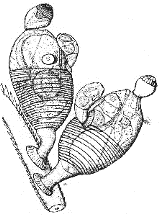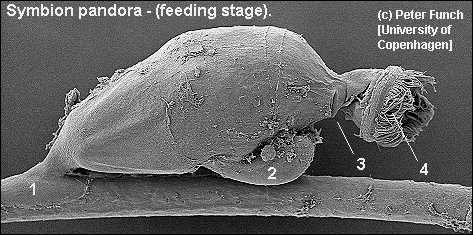Just before Christmas 1995, a new life form discovered by Danish biologists on the lips of the Norway lobster attracted world-wide media attention. Why? This topical article by Dave Walker describes and illustrates this "zoological highlight of the decade" using the biologists' published material and includes an exclusive photograph kindly supplied by the original researchers.

- Why it attracted worldwide media attention?
- The structure and life cycle of S. pandora
- An exclusive photograph of S.pandora
- provided by Peter Funch, Copenhagen University
- Beautiful annotated diagram of Pandora
- reproduced by permission of 'Nature' magazine
- Acknowledgements and Further Reading
(MacMillan Publishers).
Why the excitement
about the discovery of a new animal species and phylum?
It is not that difficult to find
a new species. Place an experienced botanist and zoologist in a poorly
investigated area of the world such as virgin rainforest and leave them
there for a while to study the fauna and flora. It is quite likely that
a tiny beetle, fly or plant such as a moss may be found which is unidentifiable
and is declared a new species. In fact it is believed that millions of
species remain undiscovered. What other marine life forms
remain undiscovered?
So why did the discovery of S.pandora excite not just the scientific community but attract media attention world-wide? For two main reasons.
Firstly, the organism was not discovered in the depths of a rain forest or an oceanic trench, but on the bristles surrounding the mouth of the Norway lobster Nephrops norvegicus which can be caught in the Kattegat Straits, a busy shipping lane between Sweden and Denmark. You've probably eaten the Norway lobster - as scampi and chips!
Secondly, when a new animal species is discovered, no matter how unusual, it can normally be classified into a known group of creatures with the same body plan or phylum. Although there are 1.5 million plus known species in the world, they can all be classified into 35 or so phyla. These include the chordates (eg the vertebrates such as man), molluscs (snails) and arthropods (jointed limbed e.g. insects).
However, S.pandora was so unusual that it could not be classified into any of the existing phyla, and a new one was suggested called Cycliophora. How was it's name derived?
The structure and life cycle of
Symbion pandora
The organism has a very complex
life cycle, with a number of well-defined sessile and free swimming stages
with different morphologies. The largest and most illustrated phase is
the feeding stage. The key features of this stage are as follows.
- typically 350 µm long
- attached by an adhesive disc to
the lips of the lobster
- feeds using a mouth surrounded
by a ring of cilia
- excretes via an anus next to the
mouth ring
- the feeding stage continually
produces inner buds which replace the feeding structures
- both asexual and sexual reproduction
can occur
View a beautiful annotated diagram of Pandora's feeding stage showing it's cellular structure.
Pandora's sex life is so peculiar that scientists at the Natural History Museum, UK were left puzzled! A museum scientist was quoted as saying 'it is unlike anything we have seen before'. There was a debate whether Pandora had one penis or two, a fact eagerly announced by the popular press!
Pandora's sexual and asexual reproductive cycle is explained and illustrated in Reference 1. The essential features of the sexual cycles are as follows.
As well as sessile (stationary)
stages there are three free-swimming stages i.e..
- a larva containing a new feeding
stage
- dwarf males (size typically 84
um) which settle on feeding stages
- females which attach to the lobster,
and subsequently degenerate producing larva which disperse.
All the free-swimming stages do not feed and are short-lived.
Sexual reproduction is initiated when the lobster is near the end of its moult cycle. At this stage sexually mature feeding stages are found attached to the lobster's lips.
The asexual aspect of the life cycle explains why large populations of feeding stages with no mature sexual stages have been found on lobsters.
Cycliophora, in which S.pandora has been placed, is thought to have affinities to the phyla Entoprocta and Ectoprocta. The Ectoprocta are also known as the bryozoans or moss animals. Bryozoans are microscopic invertebrates that can form beautiful colonies which are often attached to rocks and plants in both fresh and seawater. The bryozoans reproduce asexually by a budding process similar to that of Pandora.
Why was it
called Symbion pandora?
The observation of a feeding stage
which contains both an inner bud and a Pandora larva with a miniature feeding
stage inside, gave rise to the pandora species name i.e. a reference to
Pandora's box of Greek mythology.
Symbion is derived from the Greek syn '(together) with' and bios 'living', which refers to the close association the organism has with it's host. The phylum name Cycliophora is a Greek derivative referring to the circular mouth ring.
What other
marine life remains undiscovered?
Reinhardt Kristensen, one of the
co-discoverers of Pandora, has stated that the minutiae of marine life
have been overlooked for too long. 'This is only the beginning. When
we have finished, the zoological system will be turned upside down'.
He can speak with authority, the last phylum to be discovered, the Loricifera,
was discovered in Brittany in 1983.... by Kristensen! The Loricifera are
minute organisms which live between sand grains.
Key:
1 - adhesive disc attached to bristle
surrounding lobster's mouth
2 - dwarf male
3 - anus
4 - ring of cilia around mouth funnel
SEM image kindly supplied by Peter Funch, University of Copenhagen.
Annotation by D Walker.
The author sincerely thanks Peter Funch for sending Micscape an SEM image for this article, and congratulate him, his co-worker Reinhardt Moebjerg Kristensen and colleagues on their discovery and reporting of Symbion pandora. (The original discovery of the organism is credited in Reference 1 to T. Fenchel of the Marine Biological Laboratory, Elsinore, Denmark.)
The author and Micscape Editor would also like to thank 'Nature' magazine (Macmillan Publishers) for permission to reproduce the line drawings in or linked to this article, which were originally published in Reference 1 below.
References and Further Reading
1) "Cycliophora is a new phylum with affinities to Entoprocta and Ectoprocta" by Peter Funch and Reinhardt M Kristensen. Nature, vol 378, p711-714, 1995. This is the letter to Nature that triggered the media attention and is illustrated by superb annotated diagrams and SEM photographs.
2) "New phylum from the lobster's lips" by Simon Conway Morris. Nature, vol 378, p661-662, 1995. An interesting overview of the new discovery published in the same December 14th 1995 edition with an additional beautiful drawing. The author of this article stated that the discovery was "the zoological highlight of the decade".
3) Other magazines published summaries of the above two references. e.g. New Scientist, December 16th 1995, page 17.
Taxonomy can be a difficult subject to get to grips with, particularly because there is no definitive classification, and taxonomic groups are occasionally renamed. A good introduction to the classification of organisms is given below.
4) Encyclopaedia Britannica, 1993, vol 14, page 1088-1095. 15th Edition, 1993.
This article is based on the above references and has been written by Dave Walker an amateur microscopist and naturalist for the on-line magazine Micscape; a magazine which encourages an interest in the microscopic world. Comments on the text by Peter Funch, the co-discoverer of Symbion pandora, are appreciated but any errors are the author's i.e. Dave Walker!
